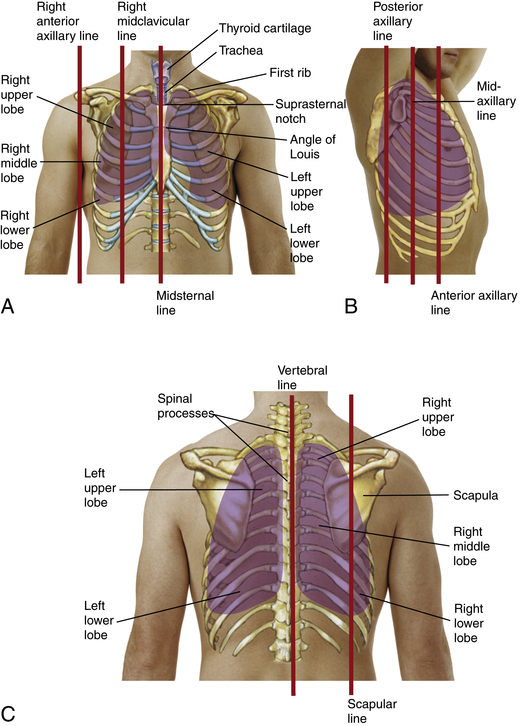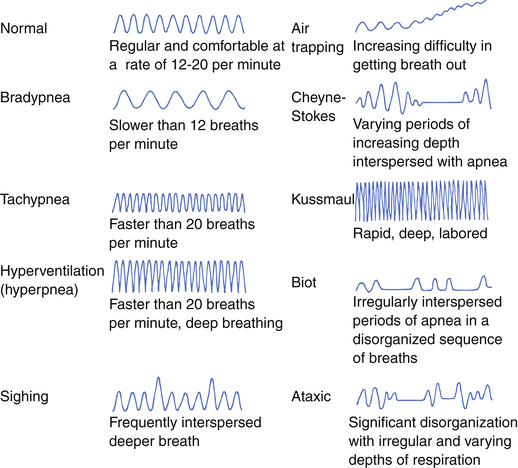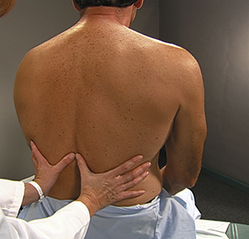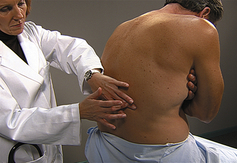Have patient sit, disrobed to waist. Stand behind patient. Place palms in light contact with posterolateral surfaces and thumbs along spinal processes at tenth rib, as shown in figure at right. Watch thumb divergence during quiet and deep breathing. Face patient; place thumbs along costal margin and xiphoid process with palms touching anterolateral chest. Watch thumb divergence during quiet and deep breathing.
Chest and Lungs
Examination
Technique
Findings
Chest and Lungs
Inspect front and back of chest
See thoracic landmarks.
EXPECTED: Supernumerary nipples possible (can be clue to other congenital abnormalities, particularly in white individuals).
EXPECTED: Ribs prominent, clavicles prominent superiorly, sternum usually flat and free of abundance of overlying tissue. Chest somewhat asymmetric. Anteroposterior diameter often half of transverse diameter.
UNEXPECTED: Barrel chest, posterior or lateral deviation, pigeon chest, or funnel chest.
UNEXPECTED: Clubbed fingernails (usually symmetric and painless; may indicate disease, may be hereditary), pursed lips, flared alae nasi.
UNEXPECTED: Superficial venous patterns. Cyanosis or pallor of lips or nails.
UNEXPECTED: Malodorous.
Evaluate respirations
EXPECTED: Breathing easy, regular, without distress. Pattern even. Rate 12-20 respirations/min. Ratio of respirations to heartbeats about 1:4.
UNEXPECTED: Dyspnea, orthopnea, paroxysmal nocturnal dyspnea, platypnea, tachypnea, hypopnea. Use of accessory muscles, retractions.
UNEXPECTED: Air trapping, prolonged expiration.
Inspect chest movement with breathing
EXPECTED: Chest expansion bilaterally symmetric.
UNEXPECTED: Asymmetry. Unilateral or bilateral bulging. Bulging on expiration.
Listen to respiration sounds audible without stethoscope
EXPECTED: Generally bronchovesicular.
UNEXPECTED: Crepitus, stridor, wheezes.
Palpate thoracic muscles and skeleton
EXPECTED: Bilateral symmetry. Some elasticity of rib cage, but sternum and xiphoid relatively inflexible and thoracic spine rigid.
UNEXPECTED: Pulsations, tenderness, bulges, depressions, unusual movement, unusual positions.
EXPECTED: Symmetric expansion.
UNEXPECTED: Asymmetric expansion.
EXPECTED: Nontender sensations.
UNEXPECTED: Crepitus or grating vibration.
EXPECTED: Great variability; generally, fremitus is more intense with males (lower-pitched voice).
UNEXPECTED: Decreased or absent fremitus; increased fremitus (coarser, rougher); or gentle, more tremulous fremitus. Variation between similar positions on right and left thorax.
Note position of trachea
Using index finger or thumbs, palpate gently from suprasternal notch along upper edges of each clavicle and in spaces above, to inner borders of sternocleidomastoid muscles.
EXPECTED: Spaces equal side to side. Trachea midline directly above suprasternal notch. Possible slight deviation to right.
UNEXPECTED: Significant deviation or tug. Pulsations.
Perform percussion on chest
Percuss as shown in figure below. Compare all areas bilaterally, following a sequence such as shown in figures on p. 98.
See table on p. 98 for common tones, intensity, pitch, duration, and quality.
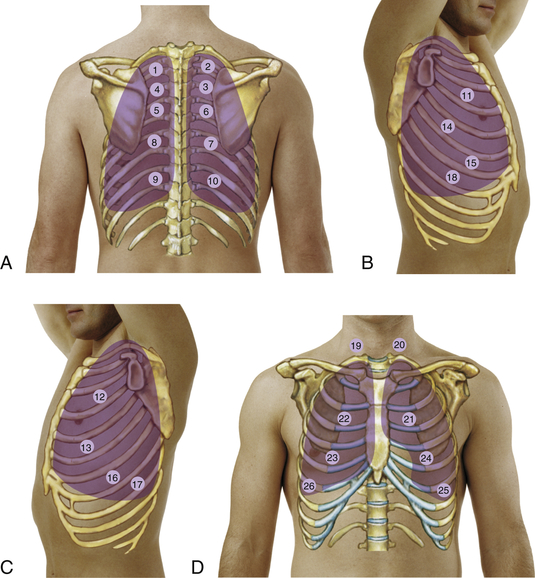
![]()
Stay updated, free articles. Join our Telegram channel

Full access? Get Clinical Tree

 Get Clinical Tree app for offline access
Get Clinical Tree app for offline access

